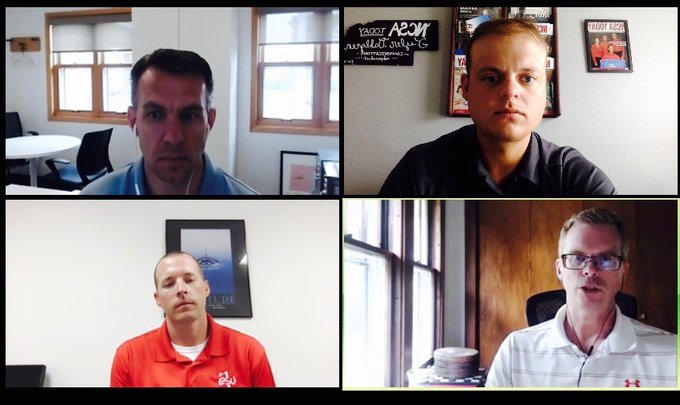Service Units Support: For ESU 1, relationships led to efficient supports during closure
Service Units Support: For ESU 1, relationships led to efficient supports during closure
By Tyler Dahlgren
This story, of how a service unit in Northeast Nebraska coordinated services for its 23 school districts in the face of a pandemic that threw a school year in an unprecedented flux, starts with an old mask analogy.
And, no, not that kind of mask. The airplane oxygen mask analogy. You’ve heard it from attendants on every single regional flight you’ve ever boarded.
“Put your oxygen mask on first before helping others.”
In other words, you’re no good to anyone else if you’re in no good shape yourself, a metaphor that rings especially true for those who spend their lives looking out for others, e.g. those who work in education.
ESUs in Nebraska exist to serve school districts. In early March, when COVID-19 knocked the 2019-20 school year completely off course, ESU 1, located in Wakefield, hit the ground running in every direction-technology support, curriculum, special education, mental health, professional development-but first, there was an assessment from within.
“We recognized that we needed to care for our own staff,” said Stuart Clark, Special Education Director at ESU 1. “We had to make sure that our people were caring for themselves, so we really prioritized that in terms of checking in with the staff.”
ESU 1 established a team, comprised of school psychologists and an LMHP, that developed a Google Form to help with initial assessments. Staff members would fill the form out periodically during the closures, rating their mental health on a 1-5 scale. Personal connections were made with staff members who needed help managing and balancing work responsibilities and adjusting to the new way of life at home.
"As an ESU, we have a good reputation of treating our people well, and the longevity of our employees shows that," said ESU 1 Administrator Bill Heimann.
While that was going on in-house, ESU 1 went to work in assisting its 22 districts through the uncertainty. Heimann established weekly Zoom meetings with district superintendents, a massive help for all parties amidst the early chaos.
ESU 1’s Teaching and Learning team began to funnel information into a singular and fluid resource document, which Heiman calls a “one-stop location” for updates from the Department of Education and best-practices being shared by school districts, who, consequently, no longer had to go searching for such materials.
“Our team did a nice job of sorting through those items that, otherwise, districts would have to filter through on their own,” said Heimann. “They relied on us to say ‘Here’s the best practices and here’s where we found them.’”
As for keeping curriculum on track, flexibility was key. Not only for ESU 1 in its approach to providing professional learning and overall support, but for the districts in incorporating new ways of doing things in alternative learning environments that students, and schools, were finding themselves in for the very first time.
“Learning didn’t stop,” said Kellen Conroy, a member of ESU 1’s Teaching and Learning team. “Teachers were working day in and day out trying to provide the best possible education and safety and sense of community for their staff, for their students, and for their communities, really.”
ESU 1's Technology Department provided Canvas licenses for all students in its districts, a majority of which were already utilizing the online learning management platform, which made material more accessible to during the quick transition to remote learning. The same went for Zoom, where a majority of interaction was held.
“We had to get really creative and innovative in using Zoom and leveraging Google Tools and the use of other high quality instructional materials,” said Conroy. “Google Sheets, Drive, all of those things to really help provide schools the support they were needing and also to help garner some feedback in terms of what our districts were looking for in terms of curriculum.”
While the last several months has reared too many challenges to count, perhaps the two most lingering clouds of uncertainty cast by the pandemic hover over the fields of mental/behavioral health and special education.
ESU 1’s Tower School Level III Program in Wayne serves, at any time, 30-35 students who travel up to 90 miles one-way for services that help meet intensive needs that can’t adequately be met in their home districts. One Board Certified Behavior Analyst works (with another employee set to take her exam in October) at the school, which, obviously, closed its physical location in mid-March. To help parents of Tower School students, who now had their hands full at home, the ESU 1 team created customized individualized learning plans for each student.
“During that process, we collaborated with parents, coaching them on ‘Okay, so you’ve got a child who is nonverbal and has autism and is eight years old and you want this time that they’re at home to be productive and educational, so here are some programs that we ran at school, here are some helpful materials, and now we’re going to watch you through Zoom and assist you with running those same programs,’” said Clark. “Sometimes we feel we’ve made some progress at school, but we don’t always have that partnership at home, but this is one of those great opportunities where we’re really collaborating and partnering with the parent.”
Near the end of the school year and through the summer, the Tower School staff was able to conduct home visits, connecting with their students outside of their homes from a safe distance. Through the pandemic, relationships with parents have actually grown stronger, and ESU 1 has, in turned, felt a reaffirming sense of appreciation from those families.
Clark uses one student as example of the good that has come out of the last four months. A student who, according to his mother, was a “yep, nope” phone conversationalist before the closures, with minimal communication and engagement skills even with family members.
“During this time, he was having Zoom and phone conversations with our staff that were lasting twenty, even thirty minutes,” Clark said. “He wasn’t just sitting in his room playing video games. He was obviously anxious to see our staff and happy that someone cared about him.”
Relationships. At the end of the day, and at the beginning of moving forward through a global pandemic, that’s what it all comes down to for ESU 1.
“Relationships are the number one thing, when we take a look at supporting not only one another at ESU 1 within our own departments and within our own teams, but also in supporting schools,” said Conroy. “Relationships are at the core of everything. We knew that we were there for one another. We knew that we were there for our schools and our schools knew that we were there for them as well.”
Such unique circumstances served as a measuring stick for those relationships, a chance to see if they were as strong as ESU 1 believed them to be. If a lack of trust between a school district and the service unit did exist, then navigating the pandemic would have surely shone a revealing light.
“What we saw was the opposite,” said Clark. “If you don’t have good relationships when there’s uncertainty and chaos and fear, then you’re going to notice that people aren’t turning to you. They aren’t trusting you. They’re maybe not willing to seek you out or consider your advice and guidance. That wasn’t the case, and we were really encouraged by that, that we were able to be there for our districts and serve them in that way because that’s what we’re all about. Increasing their effectiveness through our expertise.”
ESU 1 has a special education contract for services with each of its 22 school districts, a testament to the quality of support the service unit provides. Additionally, the service unit offers a migrant education program, which helped families in households where English isn’t the first language stay connected and up to date with resources through the pandemic.
“Those services we provide are really an extension of the relationships we have with our schools,” said Heimann.
No matter what the return to school looks like, this fall marks the beginning of another marathon for those working in education, and you can’t finish a marathon without proper training in advance.
Because there wasn’t much of a summer break, let alone a summer vacation, and because so many unknows still loom large, ESU 1 partnered with Educators Health Alliance (EHA) in coming up with customized self-assessments and wellness plans for employees over the summer.
Clark has been preparing himself over the summer for an increased need for social, emotional and behavioral supports, readying the ESU 1 team to identify when disruptive behaviors are pandemic trauma-based.
“Everyone’s lives were disrupted,” Clark said. “Everybody experienced a significant change, and so how do we care for each other this fall? Our schools will look to us for guidance, because our school psychologists partner with our school counselors and administrators to really build that depth of knowledge around how we deal with behaviors and how we establish better climate and culture for students and staff.”
The pandemic did serve as a catalyst for moving people out of their comfort zones and for becoming acclimated to new technologies. It has been an opportunity for growth.
“We’re here for efficient services, it’s what we do,” said Heimann. “This situation has forced us to look at different ways to become more efficient. It’s forcing us to get better.”
As important as innovation was in helping schools to the finish line of the 2019-20 school year, thinking outside of the box and embracing new technology and fresh ideas will be even more important moving forward into the 2020-21 slate.
ESU 1 is anxious for classes to resume in what everybody is calling the “new normal”, eager to get a gage on where they stand after so much time away. Away, but far from apart, mind you. In fact, they may just be closer than ever.
“What we did in March was okay, and what did in May was a little better,” Clark said. “I anticipate that what we do in September and beyond will continue to get better.”



